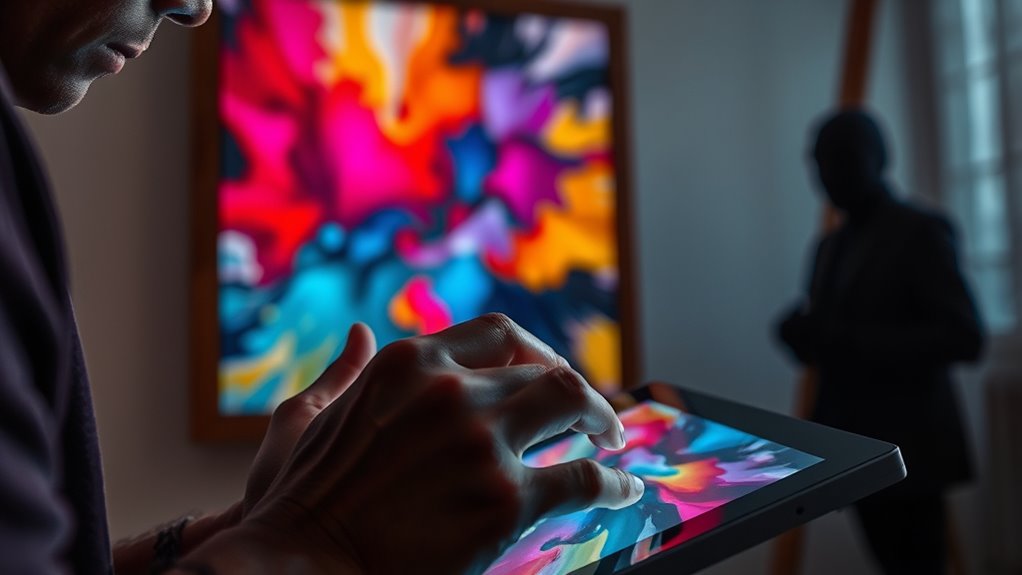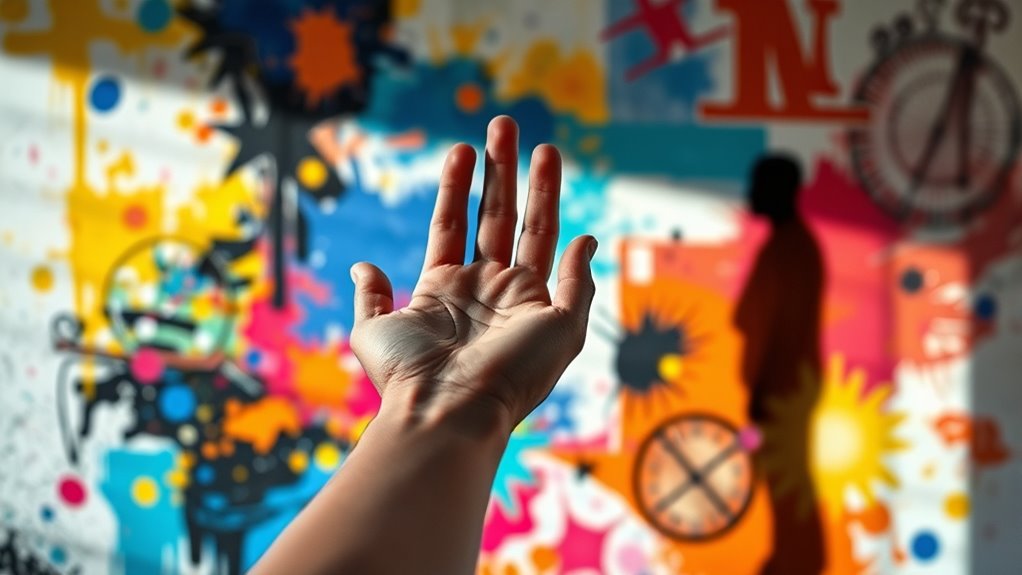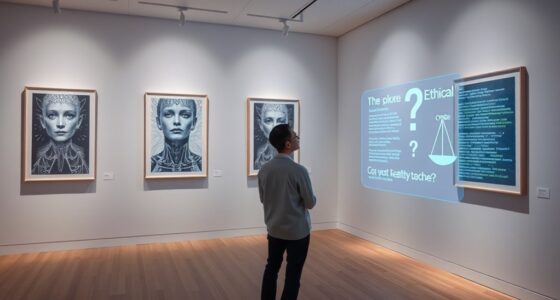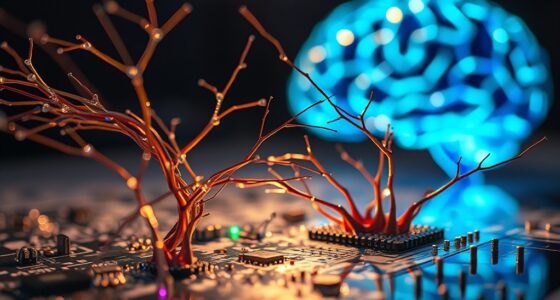The ethics of AI-generated art challenge traditional ideas of ownership and authenticity. You might wonder who truly owns a piece created by AI – the programmer, the user, or the AI itself? As AI blurs the lines of creativity, your perception of what constitutes an artist becomes essential. These legal and ethical dilemmas reshape artistic integrity and value. There’s much more to explore about how these issues affect the future of art and society.
Key Takeaways
- Ownership of AI-generated art remains ambiguous, as current laws do not recognize AI as an entity capable of holding rights.
- The role of the human creator is questioned, with debates on how much credit is due when AI assists in art production.
- Ethical concerns arise regarding the use of AI tools, with opinions divided on whether it enhances or undermines human creativity.
- Legal frameworks struggle to adapt to AI advancements, leaving gaps in protections for artists and creators of AI-generated works.
- The evolution of AI in art prompts a reevaluation of authenticity and originality, reshaping societal perceptions of artistry in the digital age.

What happens when creativity meets technology? You find yourself in a world where art can be generated in mere seconds, thanks to AI. While the innovation is exciting, it raises critical questions about ownership and authenticity. As you explore AI-generated art, you can’t help but wonder: who owns the piece? Is it the programmer, the user, or the AI itself? These questions explore the realm of intellectual property, an area that’s still grappling with the rise of artificial intelligence.
When you create something, you want to feel a sense of pride and ownership over it. With traditional art, it’s relatively straightforward. You paint a canvas, and that piece is yours. But with AI-generated art, things get murky. If you input a few prompts and an algorithm produces a stunning image, your role in the creation process feels diminished. You might question your creative authenticity. Are you still an artist if you’re merely guiding a machine?
Intellectual property laws haven’t quite caught up with the rapid pace of technological advancements. You might be familiar with copyright protections in place for traditional artists, but what about works generated by AI? Current laws often don’t recognize AI as an entity capable of holding rights. This leaves you and others in a gray area. If you use an AI to generate art, do you have the right to claim it as your own? Or is it merely a derivative work, lacking the authenticity that comes from human touch?
As you engage with AI-generated art, you’re also confronting ethical dilemmas. Is it fair for an artist to use AI tools to enhance their work or to create entirely new pieces? While some argue it diminishes the value of human creativity, others see it as a new frontier in artistic expression. You might find yourself torn between embracing this new technology and preserving the integrity of traditional artistry.
Ultimately, the intersection of creativity and technology challenges you to rethink what it means to be an artist. It forces you to consider the implications of using AI, not just for your work but for the broader artistic community. As you navigate this evolving landscape, you’ll need to confront questions of ownership and authenticity head-on, ensuring that your creative journey remains true to your vision while adapting to the technological advances around you. Additionally, the rise of subscription models for regular breakfast deliveries highlights how technology can revolutionize consumer habits and expectations in various fields.
Frequently Asked Questions
Can Ai-Generated Art Be Considered a Form of Creativity?
Yes, AI-generated art can be considered a form of creativity. While machines may lack the emotional depth of human intuition, they can produce original works that reflect unique styles and ideas. You’ll see that through algorithms, AI mimics patterns and generates images that provoke thought and evoke feelings. Though its originality stems from data, the combination of inputs can lead to unexpected and innovative results, showcasing a new dimension of creativity.
Who Decides the Value of Ai-Generated Artworks?
You decide the value of AI-generated artworks based on factors like artistic originality and cultural impact. Art collectors, critics, and the public influence this value through their perceptions and preferences. When you appreciate the unique aspects of a piece and its relevance in contemporary society, you help shape its worth. Ultimately, the evolving conversation around technology and creativity plays a vital role in how society assigns value to these new forms of expression.
Are There Copyright Laws Specific to Ai-Generated Art?
You might be surprised to learn that there aren’t specific copyright laws for AI-generated art yet. This creates some legal gray areas regarding ownership and intellectual property. Since the technology is still evolving, many artists and creators find themselves steering uncharted waters. As you explore this field, keep in mind that copyright laws may vary by jurisdiction, and it’s wise to stay informed about changes that could affect your rights and creations.
How Can Artists Protect Their Work From AI Imitation?
To protect your work from AI imitation, you should focus on asserting your copyright concerns. Register your art with copyright offices to establish clear ownership. Showcase your artistic originality by creating distinct styles or themes that are hard for AI to replicate. Consider using watermarks or digital signatures on your work. Educate your audience about your process, making it clear that your unique artistic vision is irreplaceable.
What Are the Implications for Traditional Artists?
Traditional artists face a whirlwind of challenges as AI encroaches on their territory. You’ve poured your soul into your work, and now legal recognition feels like a distant dream. This shift threatens your artistic integrity, leaving you questioning the value of your creations. It’s not just about imitation; it’s about safeguarding the essence of what makes art uniquely human. You must advocate fiercely for your rights to ensure your voice remains heard in this chaotic landscape.
Conclusion
Guiding the ethics of AI-generated art isn’t just about ownership; it’s a reflection of our values as creators and consumers. As you ponder the blurred lines between human touch and algorithmic precision, consider this: can a machine truly replicate the soul of artistry? Embracing AI’s potential while safeguarding authenticity is a delicate dance, and it’s up to you to guarantee that the art we celebrate remains a testimony to human creativity, even in this digital age.










